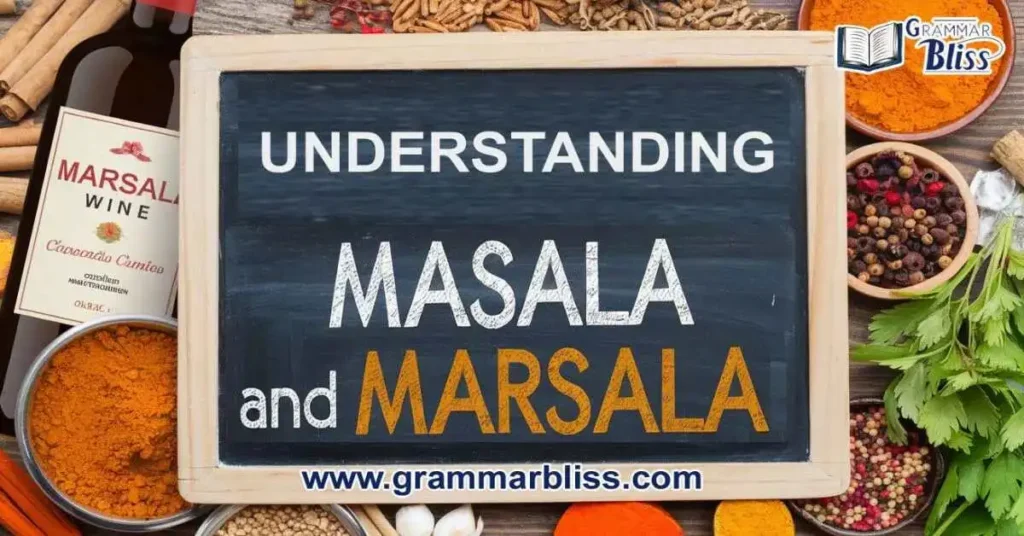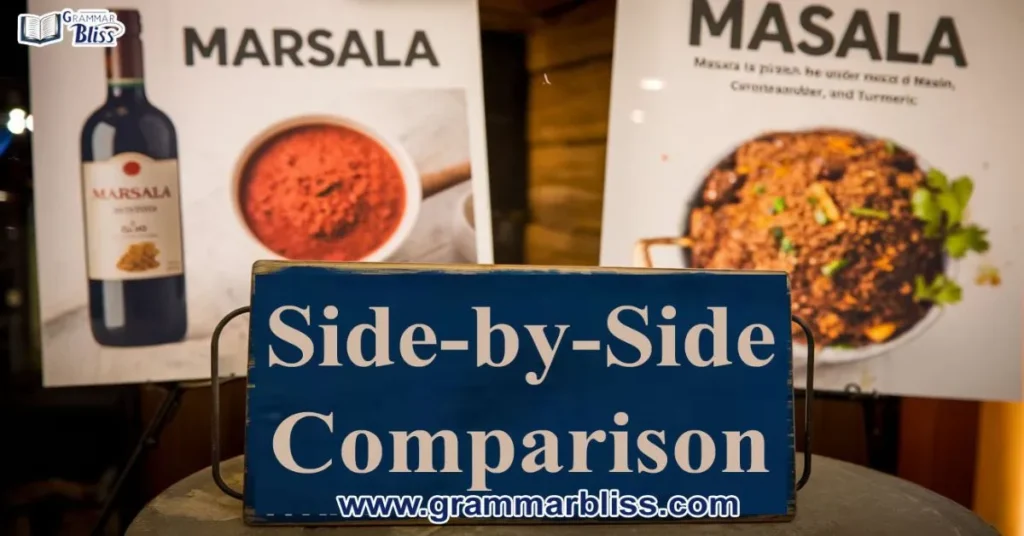When it comes to cooking, two ingredients often cause confusion due to their similar names: Masala and Marsala. While they may sound alike, these two are entirely different in both flavor profile and usage.
Masala is a blend of aromatic spices commonly used in Indian cuisine to create bold, spicy, and aromatic dishes like curries and biryani. On the other hand, Marsala is a fortified wine from Sicilian cuisine often used in cooking to add depth of flavor to savory dishes like Chicken Marsala or even desserts like Tiramisu. Understanding their distinct roles will ensure you use them correctly in your recipes.
Quick Summary
The difference between Masala and Marsala lies in their origins, ingredients, and culinary uses. Masala is a traditional Indian spice blend made from a combination of aromatic spices that serve as the flavor foundation for many dishes in Indian cuisine. On the other hand, Marsala is a fortified wine from Sicilian cuisine, used in cooking for its sweetness and nutty undertones. These two ingredients, while they sound similar, serve very different purposes in the kitchen.
Read: rest-in-peace-understanding-its-meaning-usage-and-alternatives/
Understanding Masala and Marsala

Masala and Marsala are often confused because their names sound similar, but they come from completely different parts of the world. Masala, a staple in Indian cuisine, is a spice mix that can vary widely depending on regional traditions. It’s an essential ingredient in many Indian recipes, used to add complexity and depth of flavor to everything from curries to biryani. On the other hand, Marsala is a fortified wine from the Italian region of Sicily, most famous for its use in Chicken Marsala and Tiramisu. The confusion usually arises due to the similar pronunciation, but once you understand their origins and uses, the difference becomes clear.
Masala: Definition and Usage
Masala is a Hindi word meaning “spice mix.” It is the backbone of many dishes in Indian cuisine, where it’s used to bring together a variety of bold flavors. Masala is made by blending different aromatic spices like cumin, coriander, turmeric, chili powder, and sometimes even cloves or cardamom. This blend creates a unique flavor profile that can range from earthy and spicy to slightly sweet, depending on the combination of spices.
The most common types of Masala include Garam Masala, which is typically used in Indian cooking for dishes like butter chicken or dal; Chaat Masala, a tangy blend often sprinkled on street food or fruits; and Tandoori Masala, which adds a smoky flavor to grilled meats and vegetables. Masala is highly versatile and can be used in fusion recipes too, such as Masala pizza or even spicing up Indian-inspired barbecue.
One of the unique features of Masala is its depth of flavor, which is developed by toasting the spices before blending them. This technique brings out the complexity of each spice and enhances the flavor foundation of any dish. Whether it’s a spicy curry or a rich biryani, Masala adds the necessary balance of flavors to create a memorable culinary experience.
Synonyms of Masala:
- Spice mix
- Aromatic seasoning
- Curry powder
- Indian spice blend
- Indian seasoning
Marsala: Definition and Usage
Marsala, on the other hand, is a fortified wine from Sicily, an island in the Mediterranean. It is made by adding brandy to fermented grapes, which gives the wine its rich, sweet flavor and nutty undertones. Marsala is most famous for its use in Chicken Marsala, a savory-sweet dish where the wine is used to create a wine-infused sauce that coats the chicken, adding a luxurious depth of flavor.
Marsala comes in two main varieties: sweet Marsala and dry Marsala. Sweet Marsala is used more often in dessert wine recipes, such as the classic Tiramisu, where it contributes a sweet, caramel flavor to the dessert. Dry Marsala is used more in savory dishes, enhancing the flavor complexity of meats like chicken and veal. It’s also used to make wine reductions, creating a rich, concentrated sauce.
In addition to its role in cooking, Marsala is also enjoyed as a drinking wine. It is often paired with cheese, nuts, or desserts, where its sweetness and nutty profile complement these rich flavors.
Synonyms of Marsala:
- Fortified wine
- Sweet wine
- Sicilian wine
- Cooking wine
- Dessert wine
Learn: congratulations-to-you-both-celebrating-shared-success/
Side-by-Side Comparison

Here’s a quick side-by-side comparison of Masala and Marsala:
| Feature | Masala | Marsala |
| Origin | Indian subcontinent (India, Pakistan) | Sicily, Italy |
| Main Ingredients | Aromatic spices like cumin, coriander, turmeric | Fermented grapes, brandy |
| Flavor Profile | Bold, spicy, earthy, sometimes sweet | Sweet, nutty, caramel flavors |
| Culinary Use | Used in curries, biryani, snacks | Used in savory dishes like Chicken Marsala and Tiramisu |
| Typical Dishes | Butter chicken, Paneer Tikka, Kebabs | Chicken Marsala, Tiramisu, Wine sauce |
| Type | Spice blend | Fortified wine |
Everyday Usage Examples
In Indian cuisine, Masala is an essential ingredient that can transform any dish into something unforgettable. For example, in a classic butter chicken recipe, the combination of Garam Masala and other spices creates a rich, aromatic sauce that coats the chicken perfectly. Similarly, Chaat Masala can be sprinkled on fresh fruits or snacks to add a spicy, tangy kick that makes the dish come alive.
On the other hand, Marsala shines in Italian cooking. Chicken Marsala is a classic example where Marsala wine is used to create a savory-sweet balance in the sauce. The sweet Marsala complements the richness of the chicken, while the dry Marsala enhances the depth of flavor in other meat dishes. Marsala is also a key ingredient in Tiramisu, where it adds a unique, caramel flavor to the dessert.
Explore: adjectives-with-q-enhancing-your-vocabulary/
Grammar Rule and Examples
When using Masala and Marsala in sentences, it’s important to know how to correctly refer to each in context. For instance, Masala is often used in plural form when referring to different types of spice blends. You might say, “I have several Masalas in my kitchen, including Garam Masala and Tandoori Masala.” On the other hand, Marsala is typically used in its singular form, as in, “I added a splash of Marsala wine to the sauce for extra depth.”
FAQs: Masala or Marsala
What is the main difference between Masala and Marsala?
Masala is an Indian spice blend, while Marsala is a fortified Italian wine.
Can Masala be used in place of Marsala in recipes?
No, they have very different flavors and uses, so they cannot be substituted for one another.
Is Marsala wine sweet?
Yes, Marsala is typically a sweet wine with nutty undertones and a caramel-like flavor.
What dishes use Masala?
Masala is commonly used in Indian dishes like curries, biryani, and tandoori chicken.
Can Marsala be used in desserts?
Yes, Marsala is often added to desserts like Tiramisu for a rich, sweet flavor.
Conclusion
Understanding the difference between Masala and Marsala is key to avoiding any culinary mishaps. While Masala is a spice blend that brings bold, aromatic flavors to Indian cuisine, Marsala is a fortified wine that adds sweetness and depth to both savory dishes and desserts in Italian cooking. Each has its own unique role in the kitchen, and knowing when to use them will elevate your cooking. So, next time you’re cooking, remember: Masala or Marsala, each ingredient brings something special to the table!

